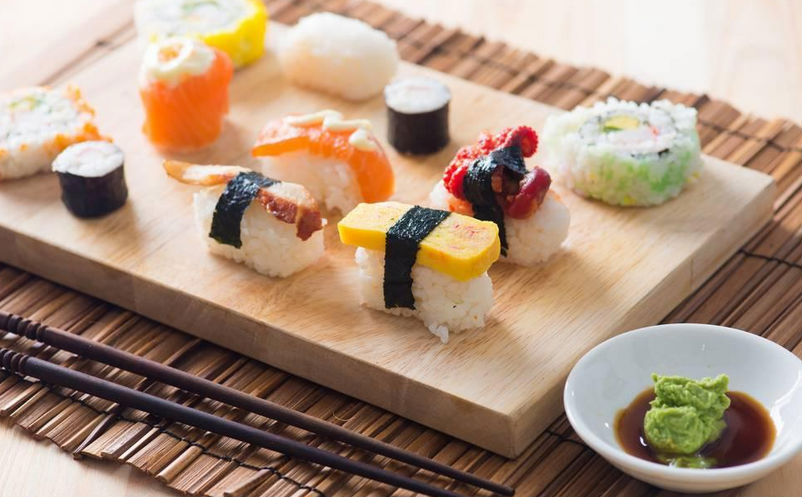(单词翻译:单击)
Whole Foods? Refrigerated section by the fish on ice. 7-11? Beside the fruit cups in light syrup.
全食超市冷藏食品区的冰鲜鱼当口有寿司;7-11什锦水果杯旁边有寿司。
Trader Joe’s? By the packaged sausage. It is everywhere.
乔氏超市包装香肠旁边也有。寿司可谓无处不在。
But as sushi made its way into foodies’ hearts across the globe,
然而,在寿司成为全世界吃货心头之好之前,
one thing has persisted in making sushi sushi.
有一个东西一直在出力,寿司才得以有今天的成就。
And it’s right there in the name.
而这个东西就在“寿司”的名字里。
The word “sushi” actually refers, not to the fish,
其实,“寿司”这个名字指的并不是鱼肉,
but to the rice that was originally used to preserve the fish.
而是原本用来给鱼肉保鲜的米。
Some of the earliest documentation of sushi comes from China thousands of years ago.
记录寿司的史料最早出现在几千年前的中国。
During the monsoon season, floods pushed fish into rice paddies
雨季来临,大水将鱼冲到各处的稻田,
and farmers who caught the fish needed a way to store them for extended periods of time.
农民把鱼捞上来以后就要想办法让鱼保存更长的时间。
So they salted the whole fish, packed it under weights with cooked rice, and sealed it in a barrel.
于是,他们给鱼撒上盐,把鱼埋到煮熟的米饭底下,然后封进桶里。
Months later, bacteria had converted sugars in the rice into lactic acid, which helped prevent the fish from spoiling.
数月之后,米饭中的糖类经细菌转化成乳酸,就能防止鱼肉腐败。
The pickled fish was eaten and the rice was tossed out.
最后人们扔掉米饭,食用腌鱼。
This preservation method spread to Japan around the 8th century,
公元八世纪左右,这一储存方法传入日本,
where they later shortened the fermentation time and began eating the sour-tasting rice with the fish.
日本人缩短了鱼肉发酵的时间,将带有酸味的米饭连同鱼肉一起食用。
And when rice vinegar was invented around 1600,
等到1600年左右米酒出现以后,
it was used to flavor the rice instead of waiting for it to ferment.
人们便不再采用自然发酵的方式,转而用米酒来提升米饭的口感。
Later, the invention of nori sometime before the 19th century led to maki, or rolled sushi.
再后来,紫菜在19世纪之前的某个时间点出现了,紫菜的发明促成了寿司卷的出现。
18th century sushi was often 3 to 4 times bigger than what we see today
十八世纪的寿司通常是我们今天看到的寿司的3-4倍,
and was served as a street food in Japan.
那时还只是一种街头小吃。
As it moved indoors, restaurants wanted to distinguish their sushi as more refined,
随着寿司走进餐厅,各大餐厅便想把寿司做得更加精致,以便与别家不同。
so they started making the petite nigiri we know today.
于是便有了我们今天看到的指握寿司。
Only after the invention of refrigeration in the 20th century did raw fish sushi become more common.
一直到了二十世纪冰箱出现以后,生鱼寿司才变得越来越普遍。
In the 1960s, sushi landed in the US and ended up at the first American sushi bar, Kawafuku, in Los Angeles’ Little Tokyo.
二十世纪六十年代,寿司登陆美国市场,从而有了位于洛杉矶“小东京”的美国第一家寿司吧“川福”。
It eventually became popular all across the US by the 1980s and the rest is history.
到了八十年代,寿司在美国已经红遍了大江南北,
Sushi rolls in particular are continuing to make their mark in American cuisine.
寿司,尤其是寿司卷今后仍将在美国料理中占有一席之地。
You’ve got the Philly roll with its very unJapanese ingredient of Philadelphia cream cheese,
我们已经有了放非常不日本的费城奶油乳酪的“费城卷”。
the the California roll made with avocados and fake crab meat.
有用牛油果和人工蟹肉做的加州卷,
And many many more nontraditional ingredients.
除了这些还有很多采用非传统食材的寿司。
"Oh my God! The sushi burrito is living."
“天啦,这个寿司玉米饼看着像活的一样。”
"This is deep-fried sushi."
“这个是炸寿司。”
It was also in the States where the maki roll was turned inside-out,
寿司也是在美国开始从米饭卷肉变成了肉卷米饭的,
reportedly in response to an American squeamishness about seaweed.
据说是因为有个美国人太喜欢吃海苔了。
But through it all, the flavor of the vinegared rice is still a staple,
然而,尽管经历了各种变化,酸米饭仍然是寿司最主要的味道,
tying today’s sushi back to its very practical past.
它传承着寿司的朴实。


